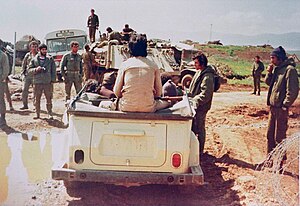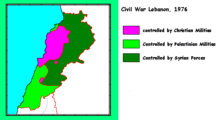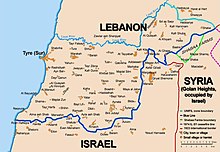1978 South Lebanon conflict
| 1978 South Lebanon conflict | |||||||||
|---|---|---|---|---|---|---|---|---|---|
| Part of the Palestinian insurgency in South Lebanon and the Israeli–Lebanese conflict | |||||||||
 Israeli soldiers meeting with Lebanese ex-military officer Saad Haddad during the invasion | |||||||||
| |||||||||
| Belligerents | |||||||||
|
|
| ||||||||
| Commanders and leaders | |||||||||
|
| |||||||||
| Casualties and losses | |||||||||
|
18 killed 113 wounded[1] | 300–550 killed[1][2][3] | ||||||||
|
1,100[2][3] to 2,000[4][5] killed in total (both combatants and civilians) 100,000 to 250,000 internally displaced[4][5] | |||||||||
The 1978 South Lebanon conflict (codenamed Operation Litani by
Background
Though it took the form of an invasion by the

Dark Green – controlled by Syria:
Purple – controlled by Maronite groups;
Light Green – controlled by Palestinian militias
As a consequence of Israeli aerial attacks from 1968 to 1977, some of the Palestinian towns and camps in southern Lebanon were totally leveled. It is estimated that by October 1977, about 300,000 refugees—mainly Lebanese Shia Muslims—had fled southern Lebanon.[6] The escalating Israel–PLO conflict increased political tensions in Lebanon between the largely pro-Palestinian Muslim population on one hand and the pro-Israel Maronite Christian and Druze populations on the other, further adding to the factors that fuelled the 1975–1990 Lebanese Civil War.[7]
In November 1977, an exchange of gunfire led to the deaths of several people on both sides of the Israel–Lebanon border and led to Israel's bombing of targets in southern Lebanon that killed 70 people, mainly Lebanese.[8]
The proximate cause of the Israeli invasion was the Coastal Road massacre that took place near Tel Aviv on 11 March 1978.[9] On that day, 11 Palestinian Fatah members led by the 18-year-old female fighter Dalal Mughrabi travelled from Lebanon to Israel, where they killed an American tourist at a beach before hijacking a bus on the Coastal Road near Haifa; the group later also hijacked a second bus that was bound for Tel Aviv. After a lengthy chase and shootout, 38 Israeli civilians, including 13 children, were killed and 76 were wounded.[10]
Course of fighting
This section needs additional citations for verification. (March 2018) |
On 14 March 1978, Israel launched Operation Litani, after the Coastal Road Massacre. Its stated goals were to push Palestinian militant groups, particularly the
The operation began with air, artillery, and naval bombardment, after which IDF infantry and armor forces, comprising about 25,000 soldiers, entered south Lebanon. The Israelis first captured a belt of land approximately 10 kilometers deep, by launching a ground attack on all PLO positions along the Lebanese border with Israel. The ground forces were led by two division commanders, and attacked simultaneously along the entire front. Paratroopers landed from helicopters to capture all the bridges on the Litani River, cutting off the possibility of retreat by the PLO, and later expanded north to the Litani River.
The IDF did not succeed in engaging large numbers of PLO forces, who retreated to the north.[11] Many Lebanese civilians were killed by heavy Israeli shelling and air strikes, which also caused extensive property damage and internal displacement.[11] According to Augustus Richard Norton, professor of international relations at Boston University, the IDF military operation killed approximately 1,100 people, most of them Palestinian and Lebanese. According to IDF reporting and internal investigation, at least 550 of the casualties were Palestinian militants initially holding the front line and killed by the IDF ground operation.[2][3] According to other sources about 2000 Lebanese and Palestinian were killed.[4][5]
Estimates for the number of people displaced by the military operations range from at least 100,000 to 250,000.
UNSC Resolution 425

In response to the invasion, the UN Security Council adopted
Resolution 425 didn't result in an immediate end to hostilities.[12] The Israelis continued military operations for 2 more days until they ordered a ceasefire.[12] The PLO's initial reaction was that the resolution didn't apply to them because it didn't mention the PLO.[12] The PLO leadership finally ordered a ceasefire on 28 March 1978, after a meeting between UNIFIL commander General Emmanuel Erskine and Yasser Arafat in Beirut.[12] Helena Cobban has described the agreement as "a turning-point in the history of the Palestinian resistance moment" because it was the first open acceptance of a ceasefire agreement with Israel that was endorsed by all official PLO bodies.[12]
Parts of the Palestinian resistance movement opposed the agreement and tried to violate the ceasefire.
Israeli forces withdrew later in 1978, turning over positions inside Lebanon to their ally, the
Palestinian factions also attacked UNIFIL, kidnapping an Irish UNIFIL soldier in 1981 and continuing to occupy areas in southern Lebanon.[15]
Hostilities continued as the Lebanese civil war escalated as fighting intensified in the south. Continued attacks in Israel from the Lebanese based PLO[16][17][18] culminated in a second Israeli invasion in 1982 resulting in a flare-up that persisted over the next decade.
Israeli withdrawal
In 2000, the UN Security Council concluded that, as of 16 June 2000, Israel had withdrawn its forces from Lebanon in accordance with Resolution 425.[19]
Lebanon has not extended control over
See also
- 1982 Lebanon War
- 2006 Lebanon War
- History of Lebanon
- Israel-Lebanon conflict
- Israeli casualties of war
- Israeli occupation of southern Lebanon
- Lebanese Civil War
- Operation Accountability
- Operation Grapes of Wrath
References
- ^ a b Kober, Avi: Israel's Wars of Attrition: Attrition Challenges to Democratic States, p. 64
- ^ JSTOR 2537858.
- ^ a b c Israeli Violations of Human Rights of Lebanese Civilians (PDF). B'Tselem. 2000. pp. 12–13.
- ^ ISBN 978-1-85109-947-4.
- ^ ISBN 978-0-89608-187-1. p.192
- ISBN 978-0-88282-163-4.
- ISBN 978-0-472-11274-6.
- ISBN 978-0-7453-1530-0.
- ^ Cobban, p. 94, Shlaim p. 369
- ^ Israeli Ministry of Foreign Affairs. Statement to the press by Prime Minister Begin on the massacre of Israelis on the Haifa-Tel Aviv Road Archived 24 June 2009 at the Wayback Machine. Historical Documents Archive: 12 March 1978.
- ^ ISBN 978-0-8047-2747-1.
- ^ ISBN 978-0-521-27216-2.
- ^ ISBN 978-1-55728-862-2.
- ^ "Extracts relating to Article 98 of the Charter of the United Nations: Supplement No 5 (1970–1978)" (PDF). Repertory of Practice of United Nations Organs. United Nations. p. 69.
- ^ Private Kevin Joyce was kidnapped and is presumed dead. See Guardian article here 20-year hunt for kidnapped Irish soldier almost over | UK news | The Observer
- ISBN 978-1-85109-841-5.
- ISBN 978-1-86189-527-1.
- ISBN 978-1-4522-0582-3.
The operation was called Operation Peace for Galilee and was launched in reply to ongoing PLO attacks from its Lebanese bases.
- ^ "Security Council Endorses Secretary-General's Conclusion on Israeli Withdrawal From Lebanon as of 16 June". un.org. Retrieved 14 March 2016.
- ^ Lancry, Yehuda (3 April 2002). "A/56/898-S/2002/345 Letter dated 2 April 2002 from the Permanent Representative of Israel to the United Nations addressed to the Secretary-General". United Nations General Assembly. Archived from the original on 21 February 2009. Retrieved 14 March 2016.
Further reading
- ISBN 978-0-415-28716-6.
- ISBN 978-1-56025-442-3.
- ISBN 978-0-393-32112-8.
- Ahmad Beydoun (1992). "The South Lebanon Border Zone: A Local Perspective". Journal of Palestine Studies. 21 (3). University of California Press: 35–53. JSTOR 2537518.
